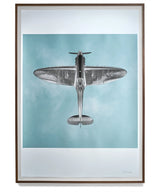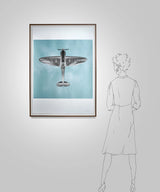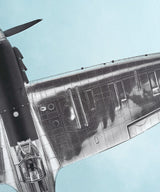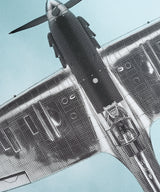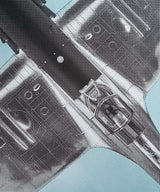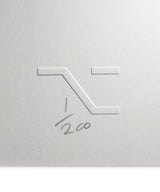- Limited to just 200 prints
- 102cm tall by 72cm wide
- Based on imagery taken of Amalgam's 1:16 scale Supermarine Spitfire Mk 1A
- Designed and created by the artist Alan Thornton
- Fine art, hand-pulled silkscreen prints
- Utilises water-based inks, printed onto 400 gsm Naturalis paper, made in England
- Created by artist and photographer Alan Thornton
This fine art screen print is of the Supermarine Spitfire Mk 1A, using a photograph of the model built by the artisans at Amalgam Collection. The Spitfire is Britain's most famous and romanticised World War II fighter, remembered and revered for its pivotal role in keeping the Luftwaffe at bay, during the Battle of Britain in the late summer of 1940. The brainchild of Reginald Mitchell of Supermarine Ltd., the Spitfire was developed in response to a 1934 Air Ministry specification and was a direct descendant of a series of Supermarine racing floatplanes the S5 S6 and S6B, that were victorious in the Schneider Trophy in 1927, 1929 and 1931. Like the seaplanes it evolved from the Spitfire featured a stressed-skin aluminium structure built around a 1,000hp, 12-cylinder, liquid-cooled Rolls-Royce PV-12 engine (later known as the Merlin). The design featured a graceful elliptical wing with a thin aerofoil that, in combination with the Merlin's efficient two-stage supercharger, gave it exceptional performance at high altitudes. More Hurricanes than Spitfires served in the Battle of Britain, and they were credited with more "kills" but the Spitfire captured the imagination like nothing else, achieving a visceral blend of visual and audial perfection.
The Process
Screen printing is the process of transferring a stencilled artwork onto a flat surface using a mesh screen, ink and a squeegee. Starting with the photography, the subject matter is composed and lit with the intermediate processes and the final print in mind - each step very much influences the final outcome. In post-production the image is refined and manipulated to create the final tonal variations needed for the separation of colours, which are then half toned which simulates continuous-tone imagery through the use of dots or lines, varying either in size or in spacing, thus generating a gradient-like effect. For each colour, a positive acetate is transferred to a silk screen frame coated in photosensitive emulsion. Following exposure, washing out and drying, the frame is mounted on a to print bed, and the chosen colour ink is then forced through the mesh with a squeegee by hand. This is a highly skilled craft process, sensitive to the touch, feel and technique of the printer, and as a result each print is unique.







